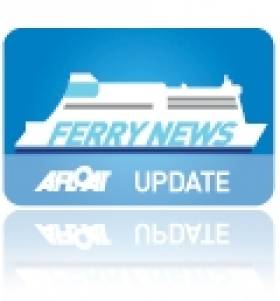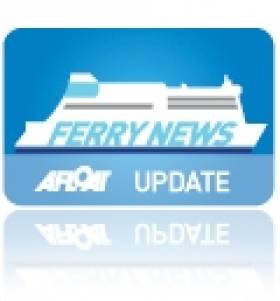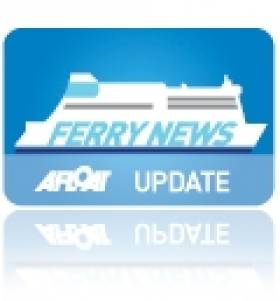Displaying items by tag: Giro D'Italia
#CycleFerry – Only seconds into the Giro d'Italia Discover Northern Ireland TV advert, there's a fleeting glimpse of a Harland & Wolff built ferry that was involved in the logistics of the last prestigious cycling race to this island, the Tour de France in 1998, writes Jehan Ashmore.
The footage shows Belfast's iconic yellow shipyard gantry cranes, Samsun and Goliath, (this weekend flooded at night in pink to reflect Giro D'Italia's pink jersey) and the former Stena Line ferry, Stena Caledonia.
As previously reported on Afloat.ie she was sold to Indonesian interests and renamed Port Link. Following the end of the three stages of the Tour de France, Stena Caledonia carried out a special chartered sailing for the cycling's vehicle entourage from Rosslare to Roscoff.
The Wexford-Breton route then, nor now, is operated by the company, though this Spring Stena Line acquired the operations of Celtic Link Ferries route to Cherbourg. Stena's first ever Ireland-continent route is served by Stena Horizon, an Italian flagged ro-pax ferry registered in Bari. After the three Irish stages, the Adriatic port is incidently the destination to where the first 'Italian' stage of the 97th Giro d'Italia finishes next Tuesday.
Likewise to the three stages of the Tour de France, the logistics involved were not only confined to Rosslare. As additional charters of two other Stena Line ferries were drafted in, Stena Challenger and Koningin Beatrix which called to Cork (Ringaskiddy ferry terminal), a first for the company. The pair also sailed to Roscoff.
Returning to the Stena Caledonia, as seen in the Giro D'Italia advert, she was berthed under the shadow of the giant gantry cranes at the Queen Island berth until her sale to PT ASDP Indonesia Ferry (Persero) and delivery voyage from Belfast Lough in 2012 as Port Link.

Portlink berthed at Belfast, close to the H&W shipyard cranes, the vessel is seen on the Giro d'Italia as the previously named Stena Caledonia, noting full Stena Line corporate livery and stern bridge. Photo Jehan Ashmore
She was the final member of a quartet of 'Saint' class ferried ordered for original owners, Sealink / British Rail and launched in 1981 as St. David.
Of the foursome, she was the only one designed with a stern-bridge so to ease operations during berthing in the restricted confines of the inner harbour in Holyhead while on the Dun Laoghaire route, in which she seldom served.
It was also apt that yesterday's 'Grande Partenza' or Big Start, saw the cyclist team trails set off from the Titanic Quarter, at the site to where a former slipway once occupied another ship built at the yard', the White Star liner RMS Titanic in 1912.
Only three years previously the Giro d'Italia was founded in 1909 and after a century later (with exceptions due to two world wars), the start of this year's Giro has for the first time begun outside mainland Europe.
P&O Ferries Gears Up Ahead of Giro d’Italia
#FerryGearsUp -With the Giro d'Italia, one of the world's most prestigious cycling events heading to Northern Ireland in May, P&O Ferries has put together special offers for travellers arriving from the UK for the major cycling event.
As previously reported on Afloat.ie, earlier this month the InCAT built 91m P&O Express reopened the 2014 season of the Troon to Larne service, and where foot passengers can travel for £30 return, while motorists can take up to a 5 day return for £119.
Alternatively, passengers can take the ferry from Cairnryan to Larne for £99 for a car plus driver or £25 for foot passengers.
Neal Mernock, Sector Director, P&O Ferries Irish Sea said: "There is huge excitement building as the Big Start approaches and we're delighted to be playing our part with these fantastic offers that will enable fans to travel to Northern Ireland to enjoy this world class event."
This is a time limited offer and bookings must be made by Sunday 11 May. Passengers can travel on this offer from Thursday 8 May to Monday 12 May 2014.
Passengers on these routes can also upgrade to the Club Lounge. Tickets booked in advance cost £12 per person while tickets purchased on board cost £14 per person.
For further information visit: www.POferries.com
Celtic Link Ferries to Go Cycling with Giro D’Italia
#CelticGiroDItalia – Celtic Link Ferries Italian flagged ro-pax Celtic Horizon will be carrying the cycling cavalcade for one of the world's greatest cycling events, the prestigious 2014 Giro D'Italia, which takes place next May with an all island staged route, writes Jehan Ashmore.
According to Wexford Chamber of Commerce, the ferry operator which runs between Rosslare-Cherbourg, recently transported a fleet of Volkswagon vehicles to see this year's Giro D'Italia in Naples.
The Giro D'Italia in 2014 will stage its 'Grande Partenza', the Big Start in Belfast and will visit Armagh and also Dublin between 10-12 May.
Hosting three-day event, which will be its 97th edition, will cost in the region of €5,000,000.
It is also estimated the event will generate to the value of €12m and which has the backing of Northern Irish Tourist Board (NITB) and Tourism Ireland.
"Celtic Link Ferries are delighted to be involved with this great event which will be the focus of the entirety of Europe" said Tourist Passenger Manager, Rory McCall.
"We are a perfect fit for something like this" added McCall. "Celtic Link Ferries will give intending passengers the best value means of travelling between Europe and Ireland with a vehicle".
Celtic Horizon which is registered in the Adriatic Sea port of Bari, has a total 2.25 kilometres of vehicle lane metres spread across its decks from where traffic is transported on the thrice weekly operated service.
Afloat.ie adds that Rosslare Europort is no stranger to such sport-related logistics, as the Tour de France made its first and only visit to Ireland in 1998.
On that occasion, ferries transported the cycling cavalcade from the Wexford port and also out of Cork to Roscoff.

























